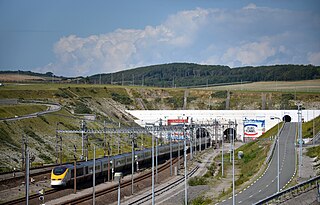
The Channel Tunnel, sometimes referred to informally as the Chunnel, is a 50.46-kilometre (31.35 mi) undersea railway tunnel, opened in 1994, that connects Folkestone with Coquelles beneath the English Channel at the Strait of Dover. It is the only fixed link between the island of Great Britain and the European mainland. At its lowest point, it is 75 metres (246 ft) below the sea bed and 115 metres (377 ft) below sea level. At 37.9 kilometres (23.5 mi), it has the longest underwater section of any tunnel in the world and is the third-longest railway tunnel in the world. The speed limit for trains through the tunnel is 160 kilometres per hour (99 mph). The tunnel is owned and operated by Getlink, formerly Groupe Eurotunnel.

High Speed 1 (HS1), legally the Channel Tunnel Rail Link (CTRL), is a 109.9-kilometre (68.3-mile) high-speed railway linking London with the Channel Tunnel.

A tunnel is an underground or undersea passageway. It is dug through surrounding soil, earth or rock, or laid under water, and is enclosed except for the portals, commonly at each end. A pipeline is not a tunnel, though some recent tunnels have used immersed tube construction techniques rather than traditional tunnel boring methods.
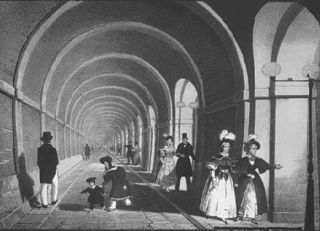
The Thames Tunnel is a tunnel beneath the River Thames in London, connecting Rotherhithe and Wapping. It measures 35 ft (11 m) wide by 20 ft (6.1 m) high and is 1,300 ft (400 m) long, running at a depth of 75 ft (23 m) below the river surface measured at high tide. It is the first tunnel known to have been constructed successfully underneath a navigable river. It was built between 1825 and 1843 by Marc Brunel, and his son, Isambard, using the tunnelling shield newly invented by the elder Brunel and Thomas Cochrane.

The City and South London Railway (C&SLR) was the first successful deep-level underground "tube" railway in the world, and the first major railway to use electric traction. The railway was originally intended for cable-hauled trains, but owing to the bankruptcy of the cable contractor during construction, a system of electric traction using electric locomotives—an experimental technology at the time—was chosen instead.
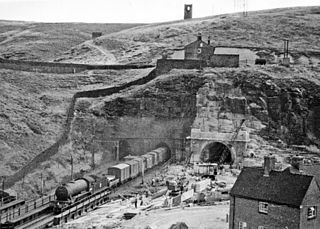
The Woodhead Tunnels are three parallel trans-Pennine 3-mile (4.8 km) long railway tunnels on the Woodhead Line, a former major rail link from Manchester to Sheffield in Northern England. The western portals of the tunnels are at Woodhead in Derbyshire and the eastern portals are at Dunford Bridge, near Penistone, South Yorkshire.

The Woodhead line was a railway line linking Sheffield, Penistone and Manchester in the north of England. A key feature of the route is the passage under the high moorlands of the northern Peak District through the Woodhead Tunnels. The line was electrified in 1953 and closed between Hadfield and Penistone in 1981.

Ayran, doogh, dhallë, dew, avamast, mastaw, shaneena, or xynogala is a cold savory yogurt-based beverage popular across Central Asia, West Asia, Southeastern Europe, North Asia and Eastern Europe. The principal ingredients are yogurt, water and salt. Herbs such as mint may be optionally added. Some varieties are carbonated.

The Jammu–Baramulla line is a railway track being laid to connect the Kashmir Valley in the Indian union territory of Jammu and Kashmir with Jammu railway station and thence to the rest of the country. The 338 km railway track will start from Jammu and end at Baramulla. It comes under the jurisdiction of the Firozpur railway division of Indian Railways' Northern zone. Part of this railway route from Udhampur to Baramulla is known as Udhampur-Srinagar-Baramula Rail Link (USBRL). The 359 m (1,178 ft) tall Chenab Bridge lies on this line, which is the tallest railway bridge in the world. The total project cost in 2022 was INR28,000 crore.
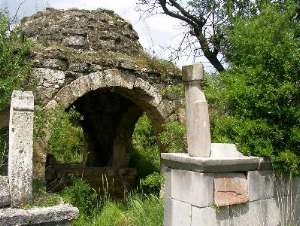
Bahçe is a town in Osmaniye Province in the Mediterranean region of Turkey. It is the seat of Bahçe District. Its population is 16,110 (2022). It is located in the Nur Mountains area.

Picc-Vic was a proposed, and later cancelled, underground railway designed in the early 1970s with the purpose of connecting two major mainline railway termini in Manchester city centre, England. The name Picc-Vic was a contraction of the two key station names, Manchester Piccadilly and Manchester Victoria. The proposal envisaged the construction of an underground rail tunnel across Manchester city centre. The scheme was abandoned in 1977 during its proposal stages due to Westminster's lack of willingness to invest in Manchester. The view was that the scheme still retained two large and expensive-to-maintain terminal stations in Manchester while other similarly sized cities had reduced their terminals to one.

The Lochaber Narrow Gauge Railway was a 3 ft narrow-gauge industrial railway. It was a relatively long line, built for the construction and subsequent maintenance of a 15-mile-long (24-kilometre) tunnel from Loch Treig to a factory near Fort William in Scotland. The tunnel was excavated to carry water for the Lochaber hydroelectric scheme in connection with aluminium production by British Aluminium. The railway came to be known colloquially as the 'Old Puggy Line'.
The Monsal Trail is a cycling, horse riding and walking trail in the Derbyshire Peak District. It was constructed from a section of the former Manchester, Buxton, Matlock and Midland Junction Railway, which was built by the Midland Railway in 1863 to link Manchester with London and closed in 1968. The Monsal Trail is about 8.5 miles (13.7 km) long and opened in 1981. It starts at the Topley Pike junction in Wye Dale, 3 miles (4.8 km) east of Buxton, and runs to Coombs Viaduct, 1 mile (1.6 km) south-east of Bakewell. It follows the valley of the River Wye. The trail passes through Blackwell Mill, Chee Dale, Millers Dale, Cressbrook, Monsal Dale, Great Longstone, Hassop and Bakewell. The trail has numerous landmarks including Headstone Viaduct, Cressbrook Mill, Litton Mill and Hassop railway station, and passes through six tunnels.
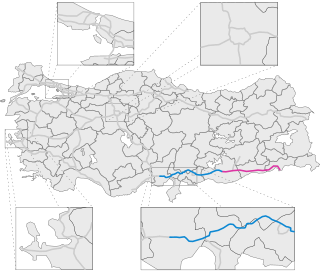
Otoyol 52, abbreviated as O-52, a.k.a.Adana-Şanlıurfa Otoyolu, is a toll motorway in the regions of Mediterranean and Southeastern Anatolia in Turkey, connecting the cities Adana and Şanlıurfa. The motorway is part of European route E90 and Asian Highway 84. The O-52 starts from the eastern terminus of The O-51, runs eastward through Osmaniye, Gaziantep and terminates east of Şanlıurfa. The O-52 is currently the second longest Motorway in Turkey being only 5 km shorter than the O-4.
Ayran Dibi is a village in Harzandat-e Gharbi Rural District, in the Central District of Marand County, East Azerbaijan Province, Iran. At the 2006 census, its population was 1,499, in 357 families.

The Ayran Tunnel, is a motorway tunnel constructed on the Adana–Şanlıurfa motorway O-52 E90 AH84 in Osmaniye Province, southern Turkey.

The Adana-Aleppo railway is a 297.4 km (184.8 mi) long electrified railway mostly in southern Turkey. The railway begins in Adana and heads east through Osmaniye, then turns south after crossing the Nur Mountains and runs into Syria. Due to the outbreak of the Syrian Civil War in 2011, the 118 kilometres (73 mi) portion of the route within Syria is mostly abandoned and in disrepair. On the Turkish side, trains run as far south to İslahiye, about 22 km (14 mi) north of the Syrian border. While the tracks south of İslahiye to the border are maintained, no scheduled trains currently run on them.
The Ayran Tunnel, also known as the Amanus Tunnel or Bahçe Tunnel, is a 4,905 m (16,093 ft) long railway tunnel in southern Turkey. It carries the Adana-Aleppo railway through the Nur Mountains, at the eastern end of the Amanian Gate. Built by the Baghdad Railway between 1908 and 1917, the tunnel is currently owned by the Turkish State Railways. The tunnel begins just east of Bahçe and ends just north of Fevzipaşa.
The Nurdağı Tunnel is a 9,950 m (32,640 ft) long twin-tube railway tunnel, currently under construction in southern Turkey. Passing through the Nur Mountains, near the east end of the Amanian Gate, it will carry passenger and freight trains along with high-speed trains, as part of the Mersin-Adana-Gaziantep high-speed railway. Upon completion, it will become the longest railway tunnel in Turkey, surpassing the 5,473 m (17,956 ft) long Deliktaş Tunnel in Sivas.
The Mersin–Adana–Gaziantep high-speed railway, known officially as the Mersin–Adana–Gaziantep higher-speed railway and abbreviated as MAG, is a 303 km (188 mi) long high-speed/higher-speed railway corridor currently under construction in southern Turkey. Beginning at Mersin, on the Mediterranean Sea, the railway corridor stretches inland to Gaziantep, via Yenice, Adana and Osmaniye. The scope of the project includes the upgrading of three existing railway lines, the construction of a new railway tunnel bypass, and the construction of a new, direct rail-link to Gaziantep.














